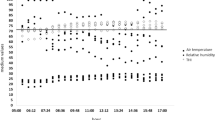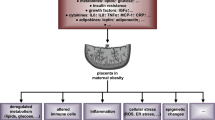Abstract
This study investigates the effects of diet-induced changes in maternal body condition on glucose tolerance in sheep. Welsh Mountain ewes were established, by dietary manipulation, at a body condition score of 2 (lower body condition [LBCS], n = 17) or >3 (higher body condition [HBCS], n = 19) prior to and during pregnancy. Birth weight and postnatal growth were similar in LBCS and HBCS offspring. In young adulthood, LBCS offspring had increased fasting glucose levels (3.8 ± 0.07 vs 3.6 ± 0.05 mM, P < .05), poorer glucose tolerance (2274 ± 22.6 vs 2161 ± 33 min/mM, P < .01), and reduced insulin secretion (0.58 ± 0.05 vs 0.71 ± 0.07 nM/min, P = .07). Increased fasting glycemia, mild glucose intolerance, and impaired initial insulin secretory response, as observed in LBCS offspring, are indictors of increased diabetes risk in humans. These findings suggest that altered maternal body composition and an imbalance between the fetal and postnatal environment influence offspring glucose tolerance.
Similar content being viewed by others
References
Hales CN, Barker DJ, Clark PM, et al. Fetal and infant growth and impaired glucose tolerance at age 64. BMJ. 1991;303(6809): 1019–1022.
Hales CN, Barker DJ. Type 2 (non-insulin-dependent) diabetes mellitus: the thrifty phenotype hypothesis. Diabetologia. 1992;35(7):595–601.
Gluckman PD, Hanson MA. The developmental origins of the metabolic syndrome. Trends Endocrinol Metab. 2004;15(4): 183–187.
Ravelli AC, van der Meulen JH, Michels RP, et al. Glucose tolerance in adults after prenatal exposure to famine. Lancet. 1998;351(9097):173–177.
Ozanne SE, Jensen CB, Tingey KJ, Storgaard H, Madsbad S, Vaag AA. Low birthweight is associated with specific changes in muscle insulin-signalling protein expression. Diabetologia. 2005;48(3):547–552.
Poore KR, Fowden AL. The effect of birth weight on glucose tolerance in pigs at 3 and 12 months of age. Diabetologia. 2002;45(9):1247–1254.
Poore KR, Fowden AL. Insulin sensitivity in juvenile and adult Large White pigs of low and high birthweight. Diabetologia. 2004;47(2):340–348.
Poore KR, Fowden AL. The effects of birth weight and postnatal growth patterns on fat depth and plasma leptin concentrations in juvenile and adult pigs. J Physiol. 2004;558(pt 1): 295–304.
Oliver MH, Breier BH, Gluckman PD, Harding JE. Birth weight rather than maternal nutrition influences glucose tolerance, blood pressure, and IGF-I levels in sheep. Pediatr Res. 2002;52(4):516–524.
Gardner DS, Tingey K, Van Bon BW, et al. Programming of glucose-insulin metabolism in adult sheep after maternal undernutrition. Am J Physiol Regul Integr Comp Physiol. 2005; 289(4):R947–R954.
Ford SP, Hess BW, Schwope MM, et al. Maternal undernutrition during early to mid-gestation in the ewe results in altered growth, adiposity, and glucose tolerance in male offspring. J Anim Sci. 2007;85(5):1285–1294.
Mardones-Santander F, Salazar G, Rosso P, Villarroel L. Maternal body composition near term and birth weight. Obstet Gynecol. 1998;91(6):873–877.
Godfrey KM, Forrester T, Barker DJ, et al. Maternal nutritional status in pregnancy and blood pressure in childhood. Br J Obstet Gynaecol. 1994;101(5):398–403.
Clark PM, Atton C, Law CM, Shiell A, Godfrey K, Barker DJ. Weight gain in pregnancy, triceps skinfold thickness, and blood pressure in offspring. Obstet Gynecol. 1998;91(1):103–107.
Haugen G, Hanson M, Kiserud T, Crozier S, Inskip H, Godfrey KM. Fetal liver-sparing cardiovascular adaptations linked to mother’s slimness and diet. Circ Res. 2005;96(1):12–14.
Gopalakrishnan GS, Gardner DS, Dandrea J, et al. Influence of maternal pre-pregnancy body composition and diet during early-mid pregnancy on cardiovascular function and nephron number in juvenile sheep. Br J Nutr. 2005;94(6):938–947.
Fall CH, Stein CE, Kumaran K, et al. Size at birth, maternal weight, and type 2 diabetes in South India. Diabet Med 1998;15(3):220–227.
Mi J, Law C, Zhang KL, Osmond C, Stein C, Barker D. Effects of infant birthweight and maternal body mass index in pregnancy on components of the insulin resistance syndrome in China. Ann Intern Med. 2000;132(4):253–260.
Shiell AW, Campbell DM, Hall MH, Barker DJ. Diet in late pregnancy and glucose-insulin metabolism of the offspring 40 years later. BJOG. 2000;107(7):890–895.
Russel AJF, Doney JM, Gunn RG. Subjective assessment of body fat in live sheep. J Agric Sci. 1969;72:451–454.
Agricultural and Food Research Council. Energy and Protein Requirements of Ruminants.Wallingford, UK: CAB International; 1993.
Ozanne SE, Dorling MW, Wang CL, Nave BT. Impaired PI 3-kinase activation in adipocytes from early growth-restricted male rats. Am J Physiol Endocrinol Metab. 2001;280 (3):E534–E539.
Fernandez-Twinn DS, Ozanne SE, Ekizoglou S, et al. The maternal endocrine environment in the low-protein model of intra-uterine growth restriction. Br J Nutr. 2003;90(4): 815–822.
Bloomfield FH, Oliver MH, Hawkins P, et al. A periconceptional nutritional origin for noninfectious preterm birth. Science. 2003;300(5619):606.
Hawkins P, Hanson MA, Matthews SG. Maternal undernutrition in early gestation alters molecular regulation of the hypothalamic-pituitary-adrenal axis in the ovine fetus. J Neuroendocrinol. 2001;13(10):855–861.
Jensen CB, Storgaard H, Dela F, Holst JJ, Madsbad S, Vaag AA. Early differential defects of insulin secretion and action in 19-year-old Caucasian men who had low birth weight. Diabetes. 2002;51(4):1271–1280.
Leahy JL. Pathogenesis of type 2 diabetes mellitus. Arch Med Res. 2005;36(3):197–209.
Author information
Authors and Affiliations
Corresponding author
Additional information
deceased
This work was supported by the National Institute of Health (AG20608) and the British Heart Foundation (F3/03/085/15929 and BS/04/001). The authors acknowledge the Biological Services Unit, Royal Veterinary College, for the routine animal care and Graham Cockrill and Keith Burling for their help with the plasma analysis.
Rights and permissions
About this article
Cite this article
Cripps, R.L., Green, L.R., Thompson, J. et al. The Effect of Maternal Body Condition Score Before and During Pregnancy on the Glucose Tolerance of Adult Sheep Offspring. Reprod. Sci. 15, 448–456 (2008). https://doi.org/10.1177/1933719107312161
Published:
Issue Date:
DOI: https://doi.org/10.1177/1933719107312161




